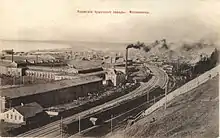Motovilikha Plants
PJSC Motovilikha Plants / Motovilikhinskiye Zavody PAO (MOTZ.MM) (Russian: Мотовилихинские заводы; MCX: MOTZ) is a Russian metallurgical and military equipment manufacturer. In 2016 Motovilikha Plants joined NPO Splav, a Rostec company.[4] It is named after the former town of Motovilikha, where it's located, which in 1938 was amalgamated into the city of Perm. The town in turn was named after the eponymous river, a small Kama tributary.
 | |
Native name | Мотовилихинские заводы |
|---|---|
| Type | Public company |
| Industry | Defense industry |
| Founded | 1736[1] |
| Headquarters | , Russia |
| Products | Artillery, Self-propelled artillery, Howitzers, Multiple rocket launchers, Military vehicles |
| Revenue | $170 million[2] (2016) |
| -$26.8 million[2] (2016) | |
| -$48.7 million[2] (2016) | |
| Total assets | $283 million[2] (2016) |
| Total equity | -$72.7 million[2] (2016) |
| Owner | Rostec (39.9%) NPO Splav (10%)[3] |
| Website | mz.perm.ru |

History

The plant was established in 1736, when Empress Anna ordered the establishment of a smelter to produce steel for the nearby factories that existed at the time, supplying steel blocks for the manufacture of rifles and guns.[1] By the late 18th century the manufacturing of weapons began in the village of Motovilikha, to meet the increasing demand.[1] Guns from Motovilikha were used in all the wars in which Russia was involved in the first half of the 19th century, including the Napoleonic Wars and the Crimean war.[1]
The second half of the 19th century saw increasing efforts to implement industrial-age manufacturing in Russia, which in 1871 led to the consolidation of all the metal smelters and weapons workshops in the region in a single facility based in the city of Perm.[1]
The plant launched the first steamship in the Urals, in 1871, and the first steam locomotive the following year.[1] In 1893, Nikolay Slavyanov introduced shielded metal arc welding while working at the Perm plant.[1] By 1914 the factory was manufacturing every third cannon in Russia.[1] The early Soviet era saw the facilities being used to manufacture a wide range of machinery, including machine tools, cranes and construction equipment.[1] After the outbreak of World War II the factory returned to the production of heavy weaponry, resuming production of civilian equipment only after the war ended.[1]
In 2011, a modern artillery production line was established at the plant.[1] Bankruptcy proceedings against the company began in March 2018,[5] and the company delisted from the stock market during the same month.[6]
Products
References
- Vershinin, Alexander (21 September 2015). "Motovilikha, unsung hero of Russia's large munitions plants". Russia Beyond The Headlines. Retrieved 2 July 2017.
- "Financial Statements 2016". Motovilikha Plants. Retrieved 8 October 2017.
- "Список аффилированных лиц". E-Disclosure.ru. Retrieved 28 April 2017.
- "Тула со смещенным центром". Коммерсантъ (Пермь). 9 February 2016. Retrieved 15 July 2017.
- ""Мотовилихинские заводы" признаны банкротом". Коммерсантъ. 26 March 2018. Retrieved 4 October 2018.
- "Об исключении ценных бумаг из Списка ценных бумаг, допущенных к торгам, и о прекращении торгов ценными бумагами". Московская Биржа. Retrieved 4 October 2018.
External links
- Official website
- Official website (in Russian)
 Media related to Motovilikha Plants at Wikimedia Commons
Media related to Motovilikha Plants at Wikimedia Commons